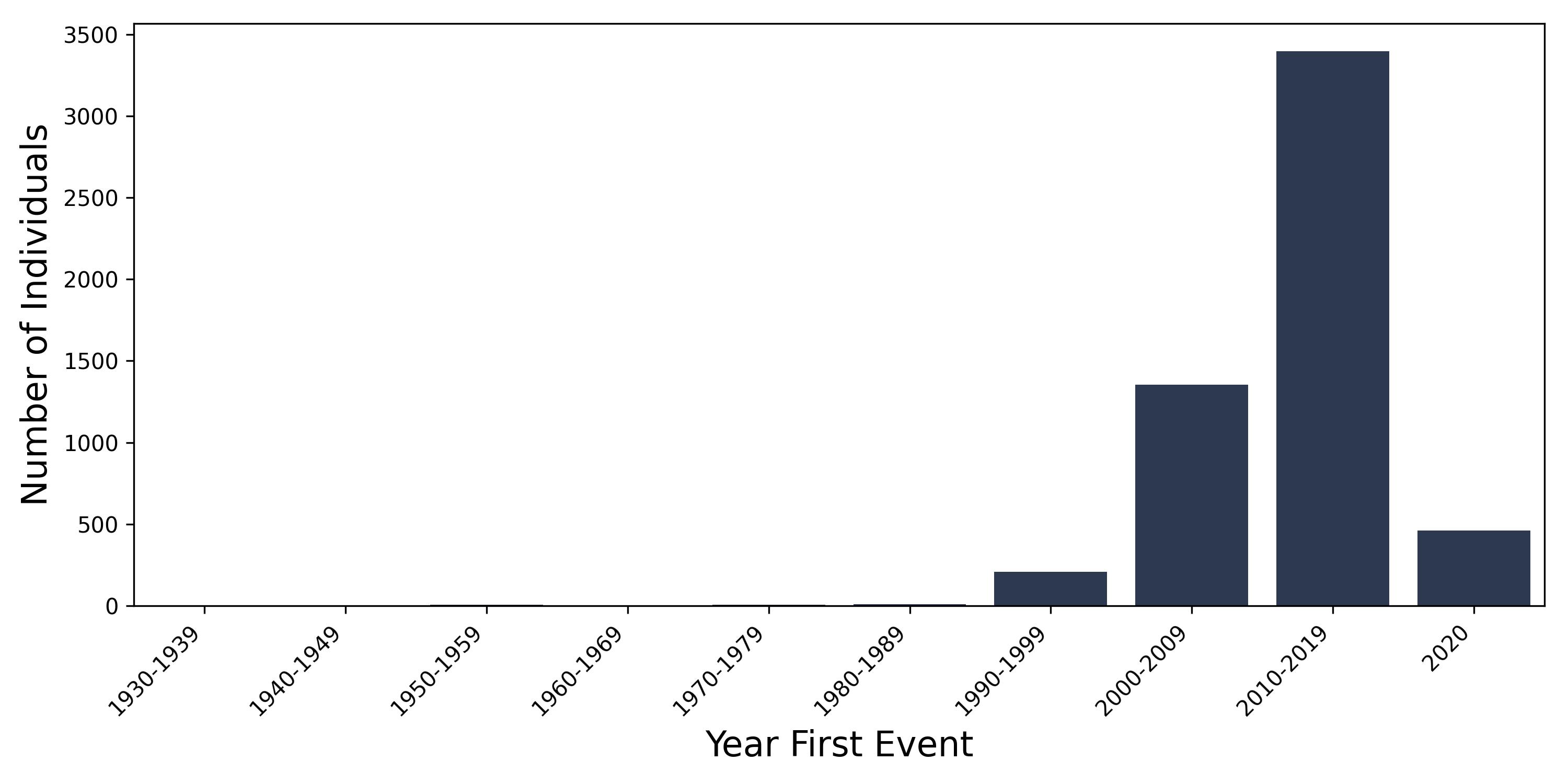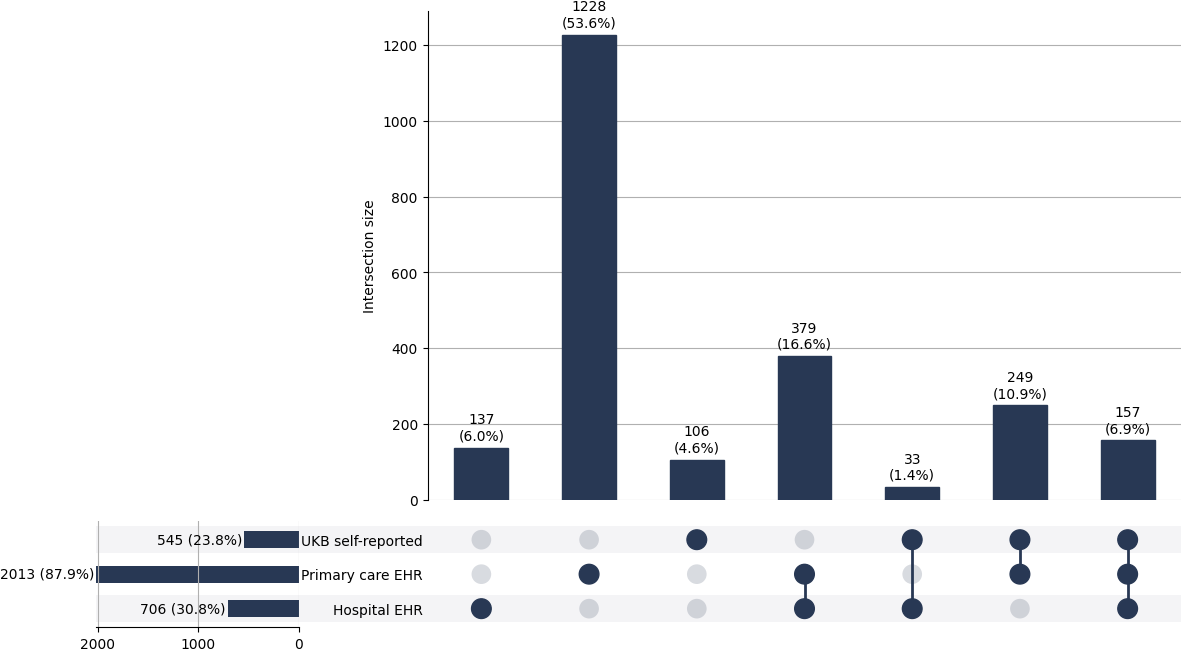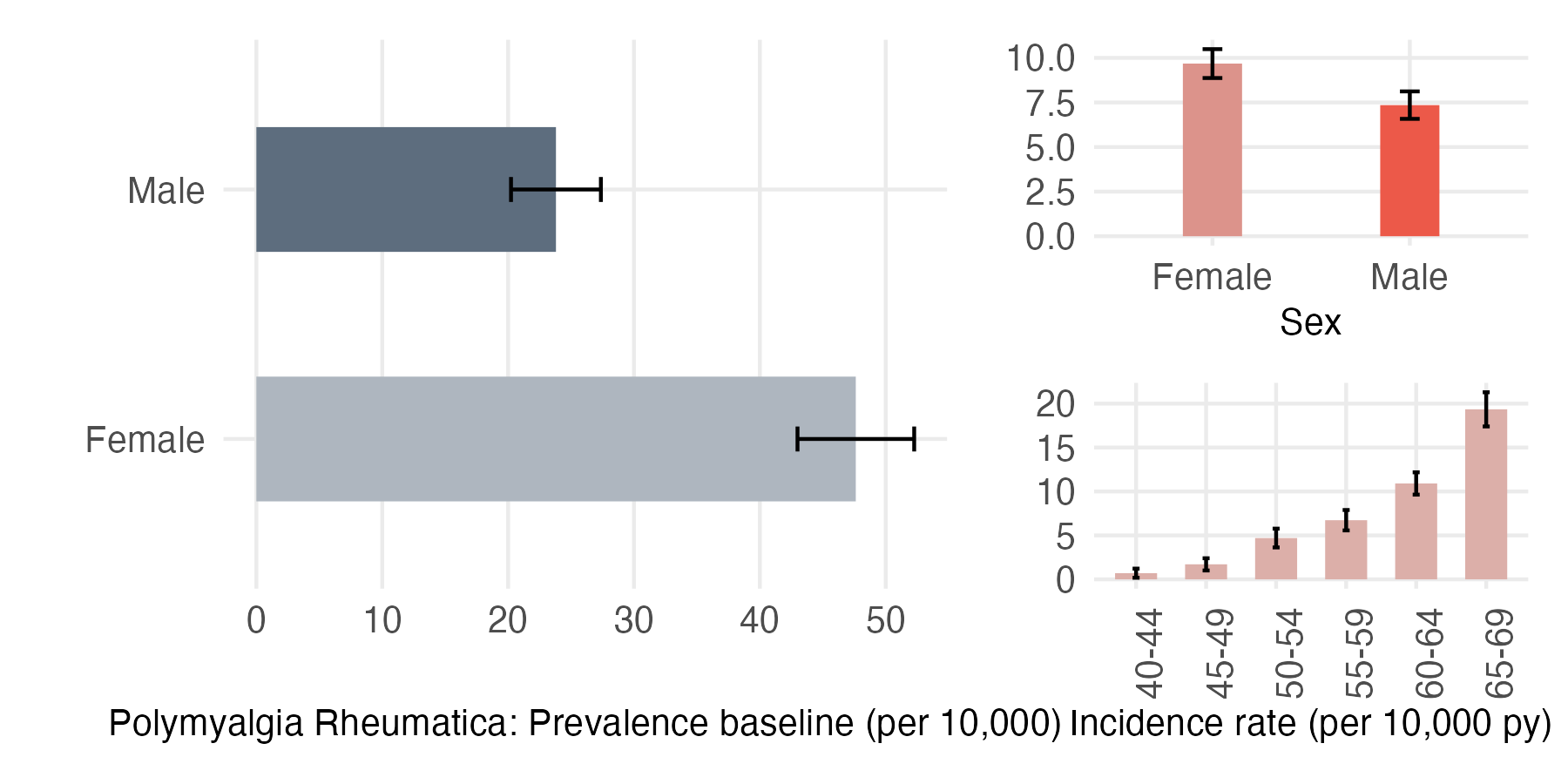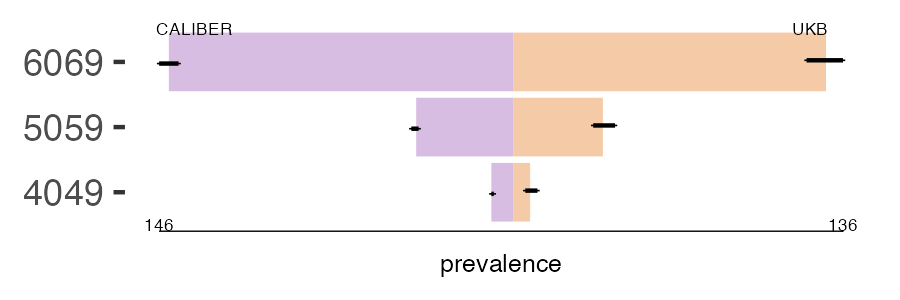| Name |
Polymyalgia Rheumatica (PMR) |
| Category |
Musculoskeletal |
| Sex |
|
| Adult |
Yes |
| UUID |
d3f6966f-5089-45e6-9e25-8cd988d45ced |
| Definition |
Polymyalgia rheumatica is a common inflammatory condition that often affects people over the age of 50 years. Characteristic symptoms are shoulder and hip girdle pain and prolonged morning stiffness. Markers of inflammation are often elevated. |
Ontologies
Key Summary Statistics
Cases from any source
| Total |
5458 |
| Female (%) |
3553 (65%) |
| Male (%) |
1905 (35%) |
Year first recorded

Cases linked in all UK Biobank sources
Cross-source concordance
Vertical bars correspond to number of cases per source/intersection; horizontal bars to left correspond to total number of cases per source.

Incidence & prevalence

Baseline prevalence stratified by sex
| Female |
47.62 (42.99,52.26) |
| Male |
23.8 (20.23,27.37) |
Incidence stratified by sex
| Female |
9.68 (8.87,10.49) |
| Male |
7.35 (6.58,8.12) |
Incidence stratified by age
| Ages 40-44 |
0.7 (0.18,1.22) |
| Ages 45-49 |
1.71 (1.01,2.4) |
| Ages 50-54 |
4.7 (3.63,5.77) |
| Ages 55-59 |
6.73 (5.57,7.89) |
| Ages 60-64 |
10.91 (9.64,12.18) |
| Ages 65-69 |
19.35 (17.4,21.29) |
Period prevalence
Methods
Comparison with general population
Sex-standardised prevalence from CALIBER study (Kuan et al. 2019)

| Population |
Ages 40-49 |
Ages 50-59 |
Ages 60-69 |
| UK Biobank |
7 (5,10) |
37 (33,42) |
129 (121,136) |
| CALIBER |
9 (8,9) |
40 (39,42) |
142 (138,146) |
Stratified by age and Townsend deprivation status
| Deprivation status |
Ages 40-49 |
Ages 50-59 |
Ages 60-69 |
| Least deprived |
9(4,19) |
41(31,53) |
133(118,151) |
| Low |
7(2,15) |
39(29,51) |
129(114,146) |
| Medium |
3(0,10) |
39(29,52) |
140(124,158) |
| High |
7(3,15) |
34(25,46) |
126(110,144) |
| Most deprived |
8(4,16) |
32(23,42) |
111(95,128) |
Stratified by age and country
| Country |
Ages 40-49 |
Ages 50-59 |
Ages 60-69 |
| England |
6(4,9) |
37(32,42) |
127(119,135) |
| Scotland |
7(2,19) |
34(23,48) |
109(91,131) |
| Wales |
16(5,37) |
43(28,64) |
181(151,216) |
Risk factors analysis
‘Healthy’ BMI, smoking status ‘never’, or no hypertension (absence of hypertension records) were considered as reference values.
Hazard Ratio (HR) values with P < 0.0002 were considered to show significant association with disease onset after correction for multiple-testing using the Bonferroni method
N=153501, Events=895
| Factor |
Level |
Hazard Ratio |
P value |
| BMI |
overweight |
1.04 (0.89, 1.23) |
0.59 |
| BMI |
obese |
1.28 (1.08, 1.52) |
0.00502 |
| BMI |
underweight |
0 (0, Inf) |
0.978 |
| smoking |
previous |
1.02 (0.89, 1.18) |
0.766 |
| smoking |
current |
0.96 (0.75, 1.23) |
0.754 |
| hypertension |
yes |
1.16 (1.01, 1.33) |
0.0425 |
Definition
| UK Biobank field id |
Description |
Code |
Value |
| 20002 |
Non-cancer illness code, self-reported |
1377 |
polymyalgia rheumatica |
| 41202 |
Diagnoses - main ICD10 |
M31.5 |
Giant cell arteritis with polymyalgia rheumatica |
| 41202 |
Diagnoses - main ICD10 |
M35.3 |
Polymyalgia rheumatica |
| 41204 |
Diagnoses - secondary ICD10 |
M31.5 |
Giant cell arteritis with polymyalgia rheumatica |
| 41204 |
Diagnoses - secondary ICD10 |
M35.3 |
Polymyalgia rheumatica |
| 40001 |
Underlying (primary) cause of death: ICD10 |
M31.5 |
Giant cell arteritis with polymyalgia rheumatica |
| 40001 |
Underlying (primary) cause of death: ICD10 |
M35.3 |
Polymyalgia rheumatica |
| 40002 |
Contributory (secondary) causes of death: ICD10 |
M31.5 |
Giant cell arteritis with polymyalgia rheumatica |
| 40002 |
Contributory (secondary) causes of death: ICD10 |
M35.3 |
Polymyalgia rheumatica |
| 42040 |
GP clinical event records |
N200.00 |
Giant cell arteritis with polymyalgia rheumatica |
| 42040 |
GP clinical event records |
N20..00 |
Polymyalgia rheumatica |
| 42040 |
GP clinical event records |
N20..11 |
Polymyalgia |
| 42040 |
GP clinical event records |
XE1FJ |
Polymyalgia rheumatica |
| 42040 |
GP clinical event records |
XE1FJ |
Polymyalgia rheumatica |
| 42040 |
GP clinical event records |
X705l |
Giant cell arteritis with polymyalgia rheumatica |



